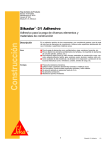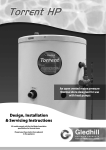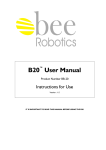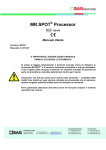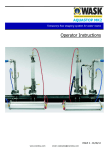Download Operators Manual Hydrant Wizard - Hy
Transcript
HYDRANT WIZARD Temporary flow stopping system for 3“ Water mains Operator Instructions ISSUE 7 - 27 Mar 09 Website: www.wask-uk.com email: [email protected] INDEX TITLE Page No. Introduction 1. 1. General Notes 2. 2. Mounting the saddle 3. 3. Drilling the pipe 4. 4. Preparing the Bagging Head 5. 5. Preparing the Pressurisation Unit 6. 7. Isolating the pipe 7. 8. Removing the stop 8. 9. Fig 1. Schematic Layout 9. Website: www.wask-uk.com email: [email protected] Introduction WASK Hydrant Wizard has been developed to stop water flow in 3“ ~ 80mm nominal bore pipes with minimal disruption. It has been designed to provide an easy to use, low cost solution to stopping flow in an operational pipeline or hydrant riser. Hydrant Wizard can be used to isolate piping systems for repair, alterations and renovation and is suitable for most pipe materials including cast iron, ductile iron, steel, PVC, and Asbestos-Cement. The system involves using an inflatable SARCO Hydra Bag™ inserted into the pipe with the specialist launch equipment through a small diameter access hole. The bag is inflated by means of water pressure in the mains, through a specially designed pressurisation unit The system comprises lightweight easy to use equipment, for up to 6 bar pressure and flow rates up to 4 litres/sec. Page 1 Website: www.wask-uk.com email: [email protected] 1. General notes A. DO NOT OPERATE THIS EQUIPMENT UNLESS YOU HAVE BEEN TRAINED IN ITS USE AN HOLD THE RELEVANT TRAINING CERTIFICATE ISSUED BY WASK B. IF ANY OF THESE INSTRUCTIONS CONFLICT WITH THOSE OF YOUR EMPLOYER, YOUR EMPLOYERS INSTRUCTIONS MUST BE OBEYED. C. ALWAYS CHECK THAT ALL PARTS ARE AVAILABLE AND IN GOOD WORKING ORDER BEFORE COMMENCING WORK. 1.1 The flow stop equipment shall comply with the latest design and all the associated equipment and fittings used during a stopping off operation shall be in sound working order. 1.2 It is important to note that to stop off the pipe at an operating pressure in excess of 6 bar or flow rate in excess of 4 litres per second and where pressure or flow reduction is not practicable, it will be necessary to use an alternative stopping off system in accordance with approved codes of practice and manufacturers recommendations. 1.3 Before a programmed stopping off operation is undertaken, the operating pressure of the main should be reduced to the lowest level at which adequate supplies can be maintained. 1.4 A work programme shall be prepared and should include schedules of all necessary safety and operational equipment and of all operational procedures. This programme should include contingency plans for the possibility of bag failure and the availability and operability of upstream and downstream line valves in case mains shut down is required. 1.5 Bag inflation pressures are automatically regulated by the Pressurisation Unit supplied with the kit. Use of other means to inflate the stopper bag may result in over inflation and possible failure of the bag and is not recommended by WASK. 1.6 Bags may be reused providing they are in sound condition and 8 hours exposure in water main is not exceeded. Page 2 Website: www.wask-uk.com email: [email protected] 2. Mounting the saddle 2.1 Clean an area approximately 75mm (3”) wide all around the pipe of all loose paint/tape/dirt/rust and inspect for large corrosion defects or markings which will impair sealing of the saddle/clamp. It may be necessary to grind off any markings which lie directly under the rubber seal. 2.2 Attach the 1 1/2“ x 3” Saddle & Strap assembly to the Riser or neck of Hydrant Tee. Note the strap can be pre-formed around the pipe to aid assembly and should be fitted with plastic cover against the pipe. 2.3 Lubricate the bolts, fit to strap and then tighten progressively by turning the bolts alternatively until a torque of 35 Nm (25 ft.lbs) is reached on both fasteners. 2.4 Ensure the 1½“ spatula can be inserted and removed easily from the slot in the body, The blade can be lubricated with Silicon Oil (WRAS listed or Wrc approved) to aid operation. 2.5 Pressure test if required using Pressure Gauge & Test Head assembly supplied with the kit. Follow your normal test practice for this, the saddle should be tested hydraulically to at least the operating mains pressure. Note :Alternatively the saddle may be pneumatically tested at between 1.0 ~ 2.0 Bar, the pressure gauge can be monitored for leaks or the saddle may be soap solution tested. 2.6 Depressurise and remove test assembly and gauge. 2.7 Check that the closure cap fits the saddle and can be screwed home, then remove and store in a safe place. 2.8 The pipe is now ready to drill. Page 3 Website: www.wask-uk.com email: [email protected] 3. Drilling the pipe 3.1 Fit the 35mm diameter Hole Saw to the drilling spindle. When cutting metallic pipes ensure the Swarf Magnet is present inside the Hole Saw. Note :Steel/Cast Iron/Ductile Iron - Use a Constant Pitch Bi-Metallic Hole Saw PVC - Use a Carbide Tipped Hole Saw Asbestos Cement - Use a Carbide Grit or Diamond Edge Hole Saw 3.2 Fit the Drilling Spindle into the Drilling Head. Disinfect and then mount the Drilling Head onto the Saddle and hand tighten to seal. 3.3 Locate and engage the ¾” square drive spanner onto the drilling spindle and lower the spindle until the Hole Saw touches the crown of the service pipe. Lightly press on the top of the spanner whilst starting the drilling process, this will centre the cutter. 3.4 Lift the Bridle and engage the Feed Screw. Continue to drill using a light feed force to carry out the drilling process. Do not try to force the saw through the cut as this could lead to breakage of the Cutter teeth. 3.5 As the Cutter begins to break through into the bore of the pipe reduce the pressure on Feed Screw. This will help reduce the size of burr produced by cutting. 3.6 Once the cut is complete, remove the Ratchet Spanner, the Drilling Spindle can then be lifted up until it reaches the stop in the Drilling Head. 3.7 Close the Saddle by inserting the 1½” Spatula. 3.8 Remove the Drilling Head and check that the coupon is still in the Hole Saw. 3.9 Remove the Drilling Spindle from the Drilling Head, remove the coupon and swarf from the Hole Saw, check Magnet is present, clean and return to tool box. Clear any swarf which may have fallen into the Saddle threads. 3.10 Fit the Pressure Gauge head to the Saddle and take a Mains pressure reading. Remove Pressure Gauge. Record this reading for future use. Page 4 Website: www.wask-uk.com email: [email protected] 4. Preparing the bag head NOTE. If this Stopper Bag has been used before, inflate and inspect for damage before installing, note limitations on reusing bags. Check both O-rings are present in bag connector. 4.1 Extend the Bag Tube until the end can be seen, remove the 3” Shoe using the 4mm Hex key and then extend the Inflation Tube until the connector is visible. 4.2 Fit the Bag to the Connector on the Inflation Tube. Tighten the Bag using the 19mm Spanner provided until a firm resistance is felt. A seal is made on the O-rings, so do not over tighten as this will not improve the seal and will only damage the equipment. 4.3 Lubricate the Bag lightly with Silicon Oil applied by aerosol (WFBS listed or WRc Approved) and draw the Bag into the Bag Tube. 4.4 Refit the 3” Shoe to the Bag Tube until hand tight using the 4mm Hex key. It is not necessary to tighten this any further. 4.5 Spray some Silicon Oil lubricant into the opening of the Bag Tube to assist the launch of the Bag. 4.6 Test launch the Bag. Align the curvature of the bag and ensure the “Sniffer” pipe will be on top when launched then align the Inflation Tube Direction Indicator to the Bag Tube Indicator, tighten using the 5mm Hex key. 4.7 Withdraw the bag into the Bag Tube. 4.8 The Bagging Head is now ready for use. Page 5 Website: www.wask-uk.com email: [email protected] 5. Bag Charger Unit check and prime. 5.1 The unit should be stored empty if it is not being used daily. Note. Blue hose – Fresh water to unit – Input Red hose – Disinfected water to bag - Output 5.2 Remove the Filler Cap and open the vent valve. Push the piston down until it bottoms out. Drop one or two Chloros tables in to the chamber and fill to top with clean water, approx 1.5 L. Refit filler cap and tighten with 36mm Spanner. 5.3 Attach the Blue hose to the upper connector on the unit. 5.4 Connect the Red hose to the connector on the Filler Cap. 5.5 Connect a waste hose or tube to the barbed connector on the unit, ¼“ or 6mm PVC tube will suffice. The Bag Charger unit and hoses are now primed for use. Page 6 Website: www.wask-uk.com email: [email protected] 7. Isolating the pipe Any jammed or corroded bolts on the Hydrant should be replaced singly before the stopping operation begins. 7.1 Disinfect then mount the Bagging Head onto the Saddle and hand tighten to seal. Slowly withdraw the Spatula to open the Saddle. Check for leaks. 7.2 Lower the Bag Tube through the Saddle into the Riser Pipe until it touches the bottom. 7.3 Rotate the Bag Tube so that both Direction Indicator faces down the Riser Pipe in the direction of the Main – DO NOT turn the Inflation Tube to do this or you risk damaging the bag or breaking the bag connection. Tighten the Bag Tube Clamp using the 12mm spanner 7.4 Launch the Bag into the Riser Pipe and secure using the Holding Bands between the handles on the Inflation Tube and Bag Tube. 7.5 The bag can now be tested in two steps prior to inflation by alternatively fitting the Bag Vent to each of the connectors on the Inflation tube. Lower connector - No water should flow from this. Upper Connector - Water should flow - this is important as no flow indicates a blockage in the bag which MUST be resolved before continuing. 7.6 Attach the RED hose to the lower connector on the Inflation tube. 7.7 Attach the BLUE hose to the top most connector on the Inflation tube. At this point water should start to flow from the flexible tube attached to the Vent Valve on the Pressurisation unit. 7.8 Close the Vent Valve, this will start the inflation of the bag. Note the piston will start to rise as water is pushed in to the Bag. 7.9 When the piston has stopped moving, depressurise and vent the Hydrant by slowly opening the Hydrant Valve. 7.10 Monitor the flow from the Hydrant and ensure the piston does not continue to move for a period of 5 minutes. 7.11 The Hydrant should now be fully depressurised and water should stop issuing with any force from the Hydrant, a small trickle can be expected. Fully open the Hydrant Valve if possible The Hydrant is now isolated and may be safely be removed. Page 7 Website: www.wask-uk.com email: [email protected] 8. Removing the stop. On completion of fitting the new Hydrant, the following steps should be taken. 8.1 A leak test may be carried out on the Hydrant by allowing it to pressurise to mains pressure by closing the Hydrant Valve once air has been bled and it has filled with water 8.2 On successful completion of the test, the Bag may be depressurised by disconnecting the Blue hose and opening the vent valve. 8.3 Release the holding bands and lift the Inflation Tube to withdraw the Bag into the bag tube. 8.4 Loosen the Bag Tube Clamp using the 12mm spanner. 8.5 The Bag Tube can now be lifted up until it reaches it’s stop. 8.6 Close the Saddle by reinserting the 1½“ Spatula. 8.7 Remove the Bagging Head and set aside. 8.8 Fit the Closure Cap to the Saddle and tighten. Remove the 1½” Spatula and fit the Plastic Cover and O-rings as required. 8.9 The Bagging Head can be reset by removing the 3” Shoe and Bag ready for the next operation. Note. If another job is going to be carried out immediately the bag can be left attached to the equipment, however DO NOT store the equipment with a bag fitted for more than 24 hours or it may become jammed. 8.10 Clean and return all the equipment and tools to the Equipment Box. Page 8 Website: www.wask-uk.com email: [email protected] Fig 1. Hydrant Wizard schematic layout Website: www.wask-uk.com email: [email protected] Page 9 Website: www.wask-uk.com email: [email protected]














